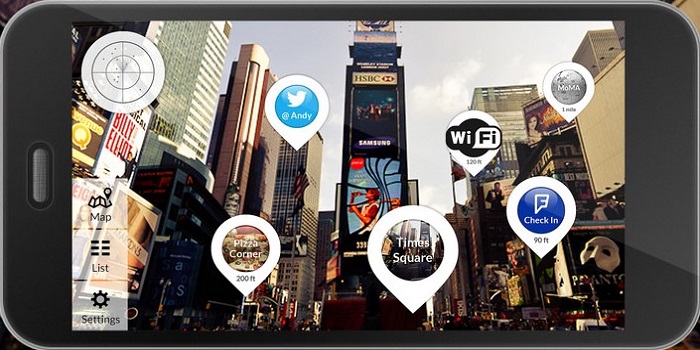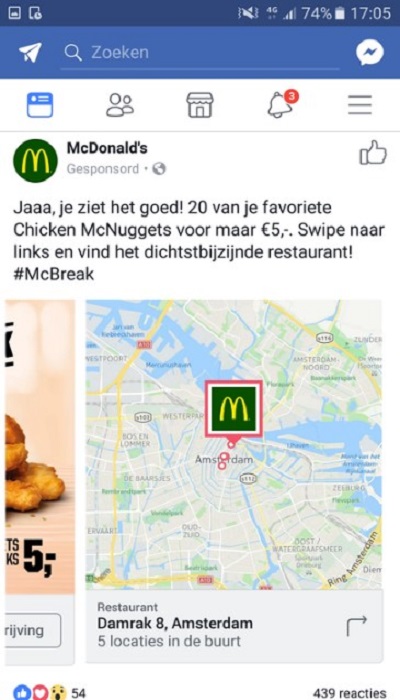MY MCDONALDS EXPERIENCE – A HOW-TO ON OPTIMIZING LOCATION-BASED ADVERTISING THROUGH MEASUREMENT
Location-based advertising is probably one of the most promising evolvements in digital advertising these days.
“Now you can actually talk to consumers when they’re near your store, or influence them where your brands are present.”
Angelique Krembs, VP of Marketing Activation, PepsiCo North America Beverages
Traditionally, location is a common theme in advertising. Consider the posters you find at bus stops, or promotion banners along highways. This traditional kind of location-based advertising primarily focuses on location itself. Companies choose locations based on the people that live in a certain place or on the people that travel through it. Also, the function of a location can be attractive for advertising (e.g. job offers in commuter areas). These days everyone has a smartphone – and most of them have their location services turned on. Companies that have access to these location details know exactly where you are. The potential impact of using this knowledge in advertising is huge as advertisements need not be fixed to a place, but can instead be shown to anyone within a radius of a place. Moreover, you can show the advertisement only to those people who have already expressed interest in your product.

“Though, I must say I’ve not had many run-ins – pun intended – so far with digital location-based advertisements.“
THE 5PM MOMENT
Until last Friday that is. It was early Friday afternoon, around 5 PM. I just got off work and was on my way to the train station. While I wait for my train to arrive, I browse Facebook to see what’s going on with my friends and family. In between the posts I see yet another Sponsored post. My feed seems to be filling up with them more and more these days. This one, however, was somewhat different. McDonalds was offering me the 20 McNuggets pack for €5 along with a route to the nearest McDonalds. I don’t actually directly pass a McDonalds when going from my office to the train station, but I catch myself thinking: “This is just what I need right now”.
I realize, at this point, that this ad is one of the most effective ads I’ve come across in a while. Why? Simply because it is so relevant!


“McDonalds managed to target me. A deep-fried-food loving 24-year old male who just finished his workweek and is on his way home. Eager for dinner – or anything that remotely resembles dinner.“
How did they manage to get to me? I’m fairly certain they don’t have my email address. I also don’t use their website. But I do like their Facebook page – and occasionally comment on it too – so I guess it is a reasonable assumption that they targeted me through there. Naturally, Facebook knows exactly where I am and I was probably within the radius of the store they listed in their ad (ca. 500m), so that works. And maybe that’s just it. McDonalds just put an ad out for this store – and perhaps other stores as well – targeting anyone that likes their Page and is within range of the store in question.
IMPROVING MEASUREMENT
Suppose McDonalds spent an X amount of euros on this campaign. How can they possibly measure their return on investment? In essence, how much revenue did the campaign generate; and was it profitable?
“To give a very short answer: there is no way they can report on that given this set-up.“
At the very best, they will get as far as the Number of Store Visits generated by the campaign. Facebook calculates this based on the Location Information from Devices (e.g. GPS), the Store Location, and a Filter to exclude employees or people moving around your store. Additionally, Facebook performs an extrapolation and uses verification polls to estimate the total number of store visits. This will tell McDonalds that a certain number of people visited a store as a result of the campaign. If the conversion window is left on default (28 days since last click; or 7 days since last view), the number of visits is likely to be inflated and unreliable as it is doubtful that a click from 28 days ago would be the cause of a visit today.

One way to be able to tell how much revenue or profit the campaign generated is to upload the orders in question to Facebook through Offline Conversion Tracking. However, McDonalds then has to be able to ascertain which orders are in fact the result of the campaign.
Ideally, you would want to tag orders to be able to recognize and isolate them. McDonalds could do that by giving a generic coupon in the ad, e.g. “MCBREAKNUGGETSFB”. They would then know which orders to upload to Facebook.
This gives a high-level overview and tells you whether the campaign was effective and/or profitable based on McDonalds’ margins. Whilst that is often considered as enough; what if you could do more?!
USING AUDIENCES

Imagine McDonalds actually had several target audiences, and I was only in one of them? Suppose that McDonalds creates ad sets for one of their stores which targets the following people in a radius of 1KM:
- Males, between 18 and 30, who commute from home to work every day
- Males, between 18 and 30, who do not commute
- Females, between 18 and 30, who commute from home to work every day
- Females, between 18 and 30, who do not commute
Imagine McDonalds splits each into 2 exposure windows, namely 2-5 PM and 5-8 PM. Conversions only count when they occur within 1 day after a view or a click.
Using the default metric, the Number of Store Visits, McDonalds gets a much clearer picture of whether males or females respond better to their campaign. Or whether commuters are more prone to react rather than inhabitants. But also the time of day aspect may reveal interesting patterns.
Naturally they should expand such testing to different stores, or different cities, to see if differences are significant enough to warrant such claims. This would help McDonalds to allocate advertising budget to the audiences with the highest Return on Investment.
As previously suggested one can pull revenue into Facebook by uploading the orders via Offline Conversion Tracking. However, this time you may be able to break it down by gender, age, and commuter or non-commuter. For instance, you could do this by adding more specific coupons into the advertisements, such as “MCBREAKM18C_UNIQUE_ID” where M stands for Male, 18 stands for the 18-30 group, C stands for Commuters, and the Unique ID is generated by one of the products that we manage and support.
CONCLUSION
